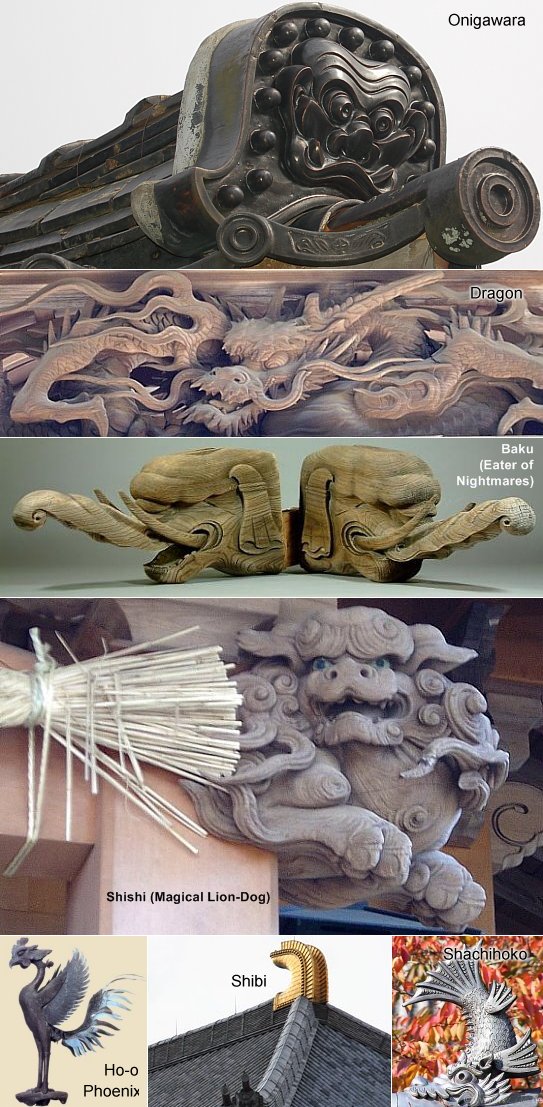Buddha Statues & Japan – December 2010
Hello Subscribers,
Knowledge and product updates for December 2010.
A-to-Z Photo Dictionary of Japanese Buddhism
» Onigawara 鬼瓦 (Literally Demon Tile or Goblin Tile)
Also known as Oni-ita 鬼板. Onigawara are goblin-faced decorative roof tiles typically placed at the ends of the main ridge on temple structures, shrines, and residences. As an ornamental architectural element, Onigawara came to prominence in Japan’s Kamakura period (1185 -1332), and were used to prevent leaks , general weathering, and to ward off evil spirits. Click here for details & photos about Onigawara. The goblin-faced Onigawara is one of many decorative elements found in Japanese religious architecture. Other examples (see photo montage below) include the magical shishi (lion dog), the elephant-like Baku creature (thought to devour nightmares), the dragon, the phoenix, and the imaginary tiger-headed fish-bodied Shachihoko. In most cases, these elements serve decorative, functional, and protective roles in preventing weathering and in warding off evil spirits, fire, etc. Today Onigawara are found most frequently on temple structures. DETAILS: http://www.onmarkproductions.com/html/onigawara-goblin-tile.html.
http://www.onmarkproductions.com/html/onigawara-goblin-tile.html
» BAKU 獏 or 貘. Eater of Nightmares.
https://www.onmarkproductions.com/html/baku.html
Major update to last month’s Baku page, with many more photos and reference notes. In particular, BAKU helps to ensure that one’s first dream (Hatsu Yume 初夢) during the New-Year holiday is favorable and auspicious, and thus Baku images and talismans are frequently placed under one’s pillow to ward off bad dreams and ill omens. Visit the Baku page, print out one of the many photos, and place it under your pillow for the coming New Year.
Updates to the Buddha Statue eStore
- Special Year-End Clearance Sale (33% to 70% Off).
Order soon to ensure delivery by Christmas.
https://www.buddhist-artwork.com/html/special-deals.html - All new Aizen Myō-ō 愛染明王 amulet. Aizen is the Impassioned One, the patron of those caught by desire or attachment. Aizen is considered the god of love among Japan’s Esoteric sects, the King of Sexual Passion, the one who converts earthly desires (love/lust) into spiritual awakening.
https://www.buddhist-artwork.com/html/aizen-amulet-boxwood.html
Upcoming Events in Japan
» Tokyo National Museum, Upcoming Exhibition Schedule.
www.tnm.go.jp/en/servlet/Con?pageId=X00&processId=01
» Nara National Museum, Upcoming Exhibition Schedule.
www.narahaku.go.jp/english/exhibition/special.html
» Kyoto National Museum, Upcoming Exhibition Schedule.
www.kyohaku.go.jp/eng/index_top
» December 16th. Gochinza 御鎮座 Festival at Tsurugaoka Hachimangū Shrine 鶴岡八幡宮 in Kamakura. This day was reportedly the day of the shrine’s establishment in 1191. Festivities start after sunset, when firewood is burned and shrine maidens and shrine priests perform ritual dances.
» December 18th. Outdoor fair at Hase-dera Temple in Kamakura. Many outdoor stalls along the approach to the temple sell numerous items that the Japanese people typically buy in preparation for the new year.
» December 23. Emperor’s Birthday, Tennō Tanjōbi 天皇誕生日. National Holiday.
» December 31. New Year’s Eve, Ōmisoka 大晦日. Not a national holiday. Preparations begin well before Dec. 31, when Japanese households, schools, and businesses clean their habitats from top to bottom. Kadomatsu 門松 (a decoration made of pine branches and bamboo) and shimekazari 注連飾り (rope of straw with strips of white paper) are placed in front of the house). Ōmisoka usually starts when families settle down to watch special New Year variety shows on television, commonly featuring popular entertainers and singers. Toshikoshi-soba 年越し蕎麦 (long, thin buckwheat noodles) are traditionally eaten.
» January 1 (early morning). New Year’s Eve, Joya-no-Kane 除夜の鐘. At the end of each year, Japanese temples strike a large bell 108 times to symbolically awaken us from our delusions. This bell-ringing tradition is called Joya-no-Kane. Many temples allow visitors to strike the bell once and make a prayer in the early hours of Jan. 1st.
» January 1. New Year’s Day, Shōgatsu 正月. National Holiday. Established in 1948, but prior to then it was an important ceremonial day of imperial worship known as Shihō-hai 四方拝. Today most Japanese businesses are closed from Dec. 29 through Jan. 3. At the beginning of the year, many Japanese visit a shrine to express gratitude for divine protection during the past year and to gain the blessings of the local kami for ongoing protection in the coming year. This first shrine visit of the new year is called Hatsumode 初詣. At Tsurugaoka Hachimangū Shrine in Kamakura alone, some two million people visit the shrine over three days during the New Year holiday. Japanese also make pilgrimages devoted to the Seven Lucky Gods during the month of January.
» Second Monday in January. Coming of Age Day or Adults Day, Seijin-no-hi 成人の日. National Holiday. Young people who have turned 20 go to a shrine for their “coming of age” ceremony. In Japan, by the way, you must be 20 years old to vote, to drink alcohol, and to drive a car.
» Feb. 3. Bean-Throwing Ceremony, 節分. A major event, but not a national holiday. People nationwide throw beans outside their home and inside their home chanting Oni wa Soto, Fuku wa Uchi 鬼は外福は内 (Get out Ogre! Come in Happiness!). See Setsubun in Japan; A Lunar New Years’ Eve by Steve Renshaw and Saori Ihara.
» For a larger list of Japan’s major holidays, see Mr. Kondo Takahiro’s web site.
asahi-net.or.jp/~QM9T-KNDU/annualev.htm
End Newsletter






